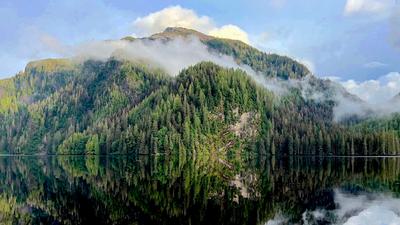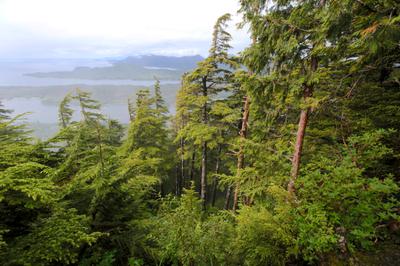On June 23, Agriculture Secretary Brooke Rollins announced the Trump Administration’s decision to abolish the rule that bans roads in 58.5 million roadless acres of the 193 million acres managed by the U.S. Forest Service, including 9.37 million acres of Tongass National Forest in southeast Alaska.
The Tongass is Earth’s largest essentially intact temperate rainforest and the ancestral homeland of the Tlingit, Haida, and Tsimshian peoples. It includes glaciers, mountains, fjords, and most of the Alexander Archipelago’s 1,100 islands. It’s drained by 15,700 miles of streams and rivers that sustain some of the continent’s healthiest populations of Pacific salmon (all five species), steelhead, rainbow, Dolly Varden, and coastal cutthroat trout. The Tongass is an important sanctuary for wildlife, much of it imperiled elsewhere. In winter, it’s warmer than my home state of Massachusetts, which it exceeds in size by 11.7 million acres.
Throughout the Tongass’s roadless section, old-growth Sitka spruce, western hemlock, red cedar and yellow cedar stabilize soil, shade and cool salmonid habitat, sequester carbon, and pump out oxygen. Some of these trees were alive in the Middle Ages.
Secretary Rollins did not mention any of that in her statement. “I’m excited to announce today… our intent to repeal the disastrous ‘Roadless Rule,’” she declared. “The heavy hand of Washington will no longer inhibit the management of our nation’s forests under the leadership of President Trump. Once again, President Trump is removing absurd obstacles to common-sense management of our natural resources by rescinding the overly restrictive Roadless Rule.”
Roadless areas provide the best habitat for fish and wildlife, a defense against climate change, and unsurpassed recreational opportunities.
As Rollins noted, this is an “intent.” Trump can’t just decree repeal. The Administrative Procedure Act requires a rulemaking process entailing notice in The Federal Register and a public comment period. And the National Environmental Policy Act requires the Forest Service to review all comments and demonstrate that it considered them in its final decision.
In 2020, when Trump announced his intent to remove roadless protection for our biggest and wildest national forest, the 16.7-million-acre Tongass, 96 percent of the public comments were opposed. Still, Trump removed protection. In January 2023, Biden restored it.
Roadless areas provide the best habitat for fish and wildlife, the cleanest water, a defense against climate change, and unsurpassed recreational opportunities. Roads would trash these values.
The Roadless Rule’s architect was President Clinton’s Forest Service chief, Michael Dombeck, a fisheries biologist. Among his first words to agency employees were these: “I want to make it clear that no Forest Service program has dominance over another. Timber is not more important than wildlife and fisheries.” Congress and President Eisenhower said precisely this in 1960 with the Multiple-Use Sustained Yield Act, a law the Forest Service had ignored.
Logging roads snake through clear-cut forest on Prince of Wales Island in Tongass National Forest. Melissa Farlow / Image Source Limited / Alamy Stock Photo
Of 1.6 million public comments, 97 percent favored Dombeck’s Roadless Rule — the greatest outpouring of public support in America’s rulemaking history. That support didn’t include Alaska’s Representative Don Young and Senators Frank Murkowski and Ted Stevens. In 2003, they got the Tongass exempted. A federal court restored protection in 2011.
Dombeck understood what previous Forest Service chiefs had not — that, short of replacing forests with, say, shopping malls, roading is the worst thing done to them. Roads create landslides. They bleed silt and sediments into rivers and lakes, obliterating fish habitat. Roads open de facto wilderness to motorized traffic, development, clear-cutting, mining, and grazing, all of which fragment forests, depleting species dependent on big, connected tracts. Elevated metal culverts, inserted where roads cross streams, block migratory fish. On the roaded section of the Tongass, at least 700 culverts cut off hundreds of miles of salmon and trout habitat.
Any timber industry dependent on old growth is doomed because, in human terms, old growth isn’t a renewable resource. That’s why Ketchikan Pulp and Alaska Pulp went belly-up in the mid-1990s. Tongass cutting rights granted by the Forest Service to these companies had totaled 41 billion board feet of timber.
Logging in southeast Alaska has been largely replaced by angling, commercial fishing, and tourism — sustainable, local economies that depend on an intact Tongass.
Now that the logging industry has extracted much of the best timber, it’s after the 30 percent of national forest that’s still roadless.
Despite the effusions of Secretary Rollins, abolishment of the Roadless Rule can’t remove “obstacles to common-sense management.” Roads are the obstacles.
A “dagger at the heart of any wilderness” is how Supreme Court Justice William O. Douglas defined a logging road in his 1965 treatise A Wilderness Bill of Rights. Nothing proved him more correct than roading in Idaho’s Nez Perce-Clearwater National Forests. By 1995, road density there exceeded that of New York City. Roads triggered 900 landslides that sent 50,000 dump truck loads worth of trees, rubble, and dirt cascading down mountains into streams and lakes.
The Forest Service can’t begin to take care of the roads it already has. Many are more than half a century old, and the road maintenance and reconstruction backlog is $8.4 billion. There are 370,000 miles of roads in our national forests, enough to circle the globe 15 times.
Roadless areas are roadless because they are steep, rocky, fragile, and water-rich — the places Big Timber originally didn’t want to go. In fact, many national forests were acquired because the industry didn’t want them. Even today, our national forests contribute less than 10 percent of the nation’s timber and pulpwood. But now that the industry has extracted much of the best timber from its land and the public’s land, it’s after the 30 percent of the national forest system that’s still roadless.
Americans pay for logging roads twice — first, with their tax dollars, then with their timber, fish, wildlife, plants, soils, and water.
Logs don’t pay their way out of our woods. More money is spent to prepare and manage timber contracts and clean up logging messes than timber sales bring in. This costs taxpayers some $2 billion annually.
And the Forest Service finances road construction via “purchaser road credits,” paying timber companies for building roads by granting them discounts on the price of timber they cut. Roads often cost more to build than the timber they access is worth, so taxpayers foot the bill.
Rollins’ June 23 announcement drew swift condemnation from environmental, angling, commercial fishing, Native American, and tourism communities. None was more strident than that from The Boat Company, a nonprofit that runs seven-day cruises from Juneau to Sitka along and in the Tongass.
“Forty-five years ago, my father founded The Boat Company because he couldn’t stand by and watch the Tongass be gutted — clear-cut by a reckless timber industry, fueled by government subsidies,” declared company president Hunter McIntosh. “And now, all these years later, I find myself in the exact same fight. The same threats. The same destruction. The Tongass isn’t a renewable resource — you can’t replant ancient trees or restore what’s been lost to greed.”
Wading up Tongass creeks, we flyfished for Dolly Varden trout — their fins trimmed with ivory, their bellies red as Alaskan sunsets.
My wife and I explored the Tongass from The Boat Company’s Liseron, a converted minesweeper that sleeps 20. From skiffs launched from the deck we caught king salmon spawned in Tongass rivers, and halibut, quill-back rockfish and yelloweye rockfish sustained by forage fish bred in Tongass wetlands.
Wading up Tongass creeks, we flyfished for Dolly Varden trout, named for the colorfully dressed character in Charles Dickens’s novel Barnaby Rudge. Their fins were trimmed with ivory, their bellies red as Alaskan sunsets.
We saw tufted puffins, humpback whales, orcas, Dall’s porpoises, and Steller sea lions. We eased up to a calving glacier whose falling ice sheets shot geysers 200 feet skyward and rocked our skiff.
Our taste of the Tongass was brief but delicious. The lack of roads didn’t hinder us or any of the other eco-tourists we met. On the contrary, it provided a wilderness experience that would have been made impossible by the roads the Trump administration wants to construct and the traffic, lodges, noise, and clear-cutting that would follow.
Much of the Tongass’s 7.33-million-acre non-roadless section is already sliced and diced with 5,100 miles of roads, 2,000 miles of them on Prince of Wales Island alone.
The island’s Thorne River made it to American Rivers’ “Ten Most Endangered Rivers” list because industrial-scale roading bleeds silt and sediments into the flow, smothering spawning and nursery habitat of salmon, steelhead, Dolly Varden, and coastal cutthroat trout. And massive clear-cutting, enabled by the roads, removes the shade these cold-water species require.
When I served on the board of American Rivers, I inspected road damage on the island and river. I wept inwardly.
Still, I learned that the Thorne retains much of its original wildness and magic and that recovery is possible. I camped under ancient western hemlocks draped with witch’s hair lichen that filtered shards of moonlight onto my sleeping bag.
And one morning, as I stood beside the Thorne, I heard what sounded like disturbed rattlesnakes. Coastal cutthroats were leaping, their fins rattling — hot fish from the cold Pacific, chowing down on pink salmon fry. I dug a Pink Lady streamer from my fly box, and one trout became my breakfast.
Port Houghton provided perhaps my best taste of the Tongass. It’s the only port in the country with no roads, no buildings, no docks, no boats, no landing strip, and no people. With me on the 85-mile flight north from Juneau were six friends from Trout Unlimited, the law firm Earthjustice and an environmental alliance called the Alaska Coalition.
Upstream, we encountered beavers, otters, wolverine and moose tracks, and a black bear still lean and ragged from hibernation.
Our Beaver float plane followed a fjord, rousting white-winged scoters and waking hauled-out Steller sea lions. What I first took to be a cloud bank rolling in from the west turned out to be ice fields of the Coast Range.
We landed on the outflow of the Rusty River in the shadows of snow-capped peaks, then carried our gear across a wet meadow and pitched tents under massive yellow cedars.
About midnight, I was awakened by wolf song from nearby timbered hills. These were Alexander Archipelago wolves — endangered in fact, if not by federal decree, by roading and old-growth logging.
In the morning, we watched ravens mob bald eagles. In the bay, glaucous-winged gulls screamed and dove into shoals of spawning candlefish. Mountain bluebirds foraged along the river, and water ouzels danced across rocks, wading into and under the current. Sand banks were festooned with vertebrae and jawbones of last year’s Pacific salmon, all of which die after spawning. Newly arrived, chrome-bright steelhead held behind boulders and deadfalls.
Upstream, we encountered beavers, otters, and a black bear still lean and ragged from hibernation. Further upstream still, we saw tracks and scats of brown bears, mountain goats, wolverines, moose, and Sitka black-tailed deer.
The Rusty River isn’t considered important enough for an official name. The name was hatched by visitors. The Alaska Department of Fish and Game didn’t know if it held coastal cutthroat trout. But I knew because I caught one. The department did suspect there were steelhead here, informing me that the annual run was probably less than 50. But the run was only a few days old, and we’d already seen close to that number.
As I cast to steelhead and gazed at the beauty and wildness around me, I recalled the words of Earthjustice’s Marty Hayden, uttered the previous night as we sat around our campfire: “We’re losing places like this before we even know we have them.”



